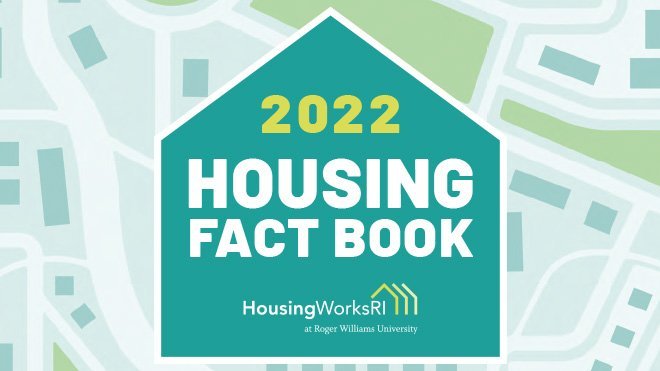HousingWorks RI at RWU Report: Affordable Housing Key to Improving Well-Being
The 2022 Housing Fact Book looks beyond pandemic to analyze housing affordability as key to growing opportunities for well-being

PROVIDENCE, RI – The 2022 Housing Fact Book released today by HousingWorks RI (HWRI) at Roger Williams University explores the response to the COVID-19 pandemic and the resources made available for housing affordability and Rhode Islanders’ well-being. This year’s publication provides an overview of how the Ocean State can take what has been learned from the changing environment and get to a place of equitable opportunity for its residents.
Rhode Island’s median single family home price in 2021–$365,000–reflected a one-year increase of 14 percent; the highest single year increase since the last spike in prices during 2001-2004. With the cost of housing increasing, it is no surprise that the rate of cost burden in Rhode Island remains a challenge for many. Over 139,000 Rhode Island households are cost burdened, meaning they spend more than 30 percent of their income on housing. Among renter households, across most racial/ethnicity categories, more than one in five pays over 50 percent of their income to housing costs, making them housing insecure. When a Rhode Islander is cost burdened, it not only prevents households from circulating money back into their local economies, it can also hinder the opportunity to save, or obtain other essentials such as healthcare, transportation, and child care.
“Housing professionals across the state understand that despite differing lifestyles and needs, everyone benefits from having a home that fits their budget and connects them to amenities that provide quality of life,” explains Stephen Antoni, HousingWorks RI’s Advisory Board Chair. “For some, that means public transit and proximity to a well-paying job; for others, it means a high-performing school district and open spaces. In the end, a home is much more than just four walls, it actually shapes one’s opportunities in life.”
Continuing its work from 2021, this year’s regional section offers new perspectives on balancing land use with equitable access to opportunities that are enhanced by housing affordability. Across Rhode Island, anywhere from 64 percent to 82 percent of its regions’ residents could not afford the median single family home. New research on zoning notes four out of seven regions having less than five percent of their unprotected land as zoned for multifamily by right. The section also offers insights into equity factors that connect to the Social Determinants of Health indicators, such as transit costs, jobs, access to high-performing schools, and recreation.
Brenda Clement, Director of HousingWorks RI notes: “We must continue to work together across the state with all our municipalities to implement the framework that will enable a diversity of housing options for our residents–through infrastructure and revised land use regulations. HUD has reported that Rhode Island is the only New England state where multifamily construction declined in each quarter year-over-year from Q4-2021 through Q2-2022. Also, our rental vacancy rates are a full five percentage points below what is considered healthy.We simply need more production of all kinds of homes, and to preserve and upgrade the stock we have. Funding is a big part of that, and we have taken important steps toward funding housing with the latest $65M housing bond, and our new permanent funding stream in the state’s budget; however, even with these valued investments, the 2022 Housing Fact Book notes that the state funds approximately only a quarter of our housing programs—relying on federal dollars for the vast majority. Our state still has a long way to go in order to do its part in combating the housing affordability crisis.”
Other key facts regarding affordability from this year’s book include:
- Based on 2021 median single family home prices, a household earning the state’s median household income of $70,305 would not be able to buy a home affordably in any of Rhode Island’s cities and towns
- Rhode Island households earning $50,000 or less could affordably rent in only three municipalities–Burrillville, Bristol, and Woonsocket–and households earning the median renter income of $38,339 could affordably rent the average 2-bedroom apartment in only one Rhode Island municipality–Burrillville.
- Figures for those who are chronically homeless and unsheltered are up 105 percent, and up 35 percent for adults experiencing homelessness.
- Highlighting the disparity between the cost of housing and wages, nearly 70 percent of the jobs identified as “high growth occupations” in the Rhode Island Department of Labor and Training’s Occupational Outlook 2028 do not pay the hourly “housing wage” of $24.32, identified by the National Low Income Housing Coalition’s 2022 Out of Reach Report. Rhode Island’s median single family home price ($365,000) suggests an hourly wage of $46.38 is needed to afford housing costs–nearly double that of NLIHC’s ‘housing wage.’
HousingWorks RI released the 2022 Housing Fact Book this morning during a breakfast event at Hotel Providence. Community partners, industry leaders, and elected officials gathered to listen to a presentation of this year’s key findings and takeaways by Annette Bourne, HousingWorks RI’s Research and Policy Director, and Bryce Kelley, HousingWorks RI’s Research Analyst. Following a report out of the Housing Fact Book and recent zoning work, local elected officials shared brief remarks, with HWRI recognizing Congressman Langevin for his years of service and support.
The 2022 Housing Fact Book can be found electronically at www.housingworksri.org.